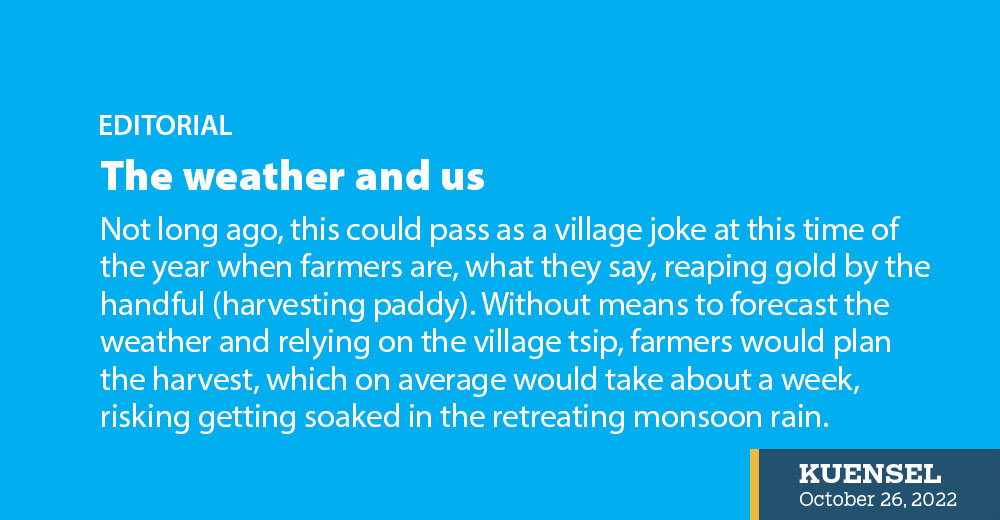“Aum Zamu, it is going to rain tomorrow. Cancel your harvest!”
Not long ago, this could pass as a village joke at this time of the year when farmers are, what they say, reaping gold by the handful (harvesting paddy). Without means to forecast the weather and relying on the village tsip, farmers would plan the harvest, which on average would take about a week, risking getting soaked in the retreating monsoon rain.
It has changed. Aum Zam could trust the forecast. With improved technology and expertise, the National Centre for Hydrology and Meteorology (NCHM) can now forecast weather almost accurately for the next day and up to 50-60 percent accuracy for the next three days.
Forecasting the weather accurately is still a challenge, but knowing the behaviour of the atmosphere and sending early warnings could make a difference to our farmers. The Centre’s warning of rain since October 24 evening, it was confirmed, prevented many farmers in the Punakha-Wangdue valley from harvesting their paddy.
It is the peak paddy harvest season and any intervention to save the fruit of hard work would be appreciated. The Centre is trying hard to improve the weather forecast. There is an ongoing project funded by the Japan International Cooperation Agency (JICA). We hope it will further improve weather forecasting.
However, forecasting alone is not the end in preventing disasters. It is only a part of the solution. What is crucial is in disseminating the information. People can heed to warnings only when they are aware. The overcast sky on Monday across the country could have raised the farmer’s antenna. Many do not follow the news. If they did, it could have influenced their decision to postpone.
The government has invested millions in the NCHM with the hope to prevent disasters among many other objectives. The centre has progressed and can intervene in many ways. However, if the crucial information they generate is not reaching the needy, it is a waste of resources.
When it comes to rain, erratic or more than needed, the farming community is the most affected. Information could influence decisions on whether to start transplanting paddy or harvest them. This is where the local governments should come in and play an important role. Developments in information technology have enabled even a farmer to use social media. Social media applications like Wechat or WhatsApp are rampantly used and could make a difference. If the Gup or the Tshogpa, is in touch with the NCHM for possible rain or storm, they could share it with the people in their village, chiwog or gewog.
What we need to do is improve the information-sharing apparatus. Social media is a boon here if the official with crucial information is not scared or needs the permission of the boss on tour to share it. Many farmers rue that their year-long hard work is undone in a day when, for instance, rain damages harvested paddy.
However, there are areas where farmers could look beyond the weather forecast. Mechanising agriculture is one. Farmers even today practice the cut-and-dry method when harvesting paddy. The paddy can be damaged at all stages. With mechanisation, the risk could be eliminated. Last year, farmers who used harvesters from the farm machinery centre managed to save their gold. The others had to gather their paddy from the flooded fields.


